By Miquel Pellicer and Nils Strecker
Marburg is a mid-sized university town with beautiful, picturesque architecture and a long history of both academic and economic success. Marburg University is one of the oldest universities in Germany, founded in 1527. In 1901, the very first Nobel prize in medicine was awarded to Emil von Behring for the discovery of the diphtheria antitoxin. He used the prize money to start his own production plant for antitoxins and vaccines in Marburg . Over time, the Behringwerke complex developed, where more and more pharmaceutical companies settled and now form a highly specialized cluster. Very recently BioNTech opened a production plant for its Covid vaccine, inducing a massive spike in tax income for the city.
Marburg also features a history of progressive politics: Social democrats and the green party have filled Marburg’s governing positions for decades, not least because it is heavily populated by students, which tend to be active in progressive causes. This together with the city’s economic and intellectual prowess, conjures an image of Marburg as a place of prosperity and social cohesion. The city center, with its picturesque, and sumptuous buildings, conforms perfectly with this image.
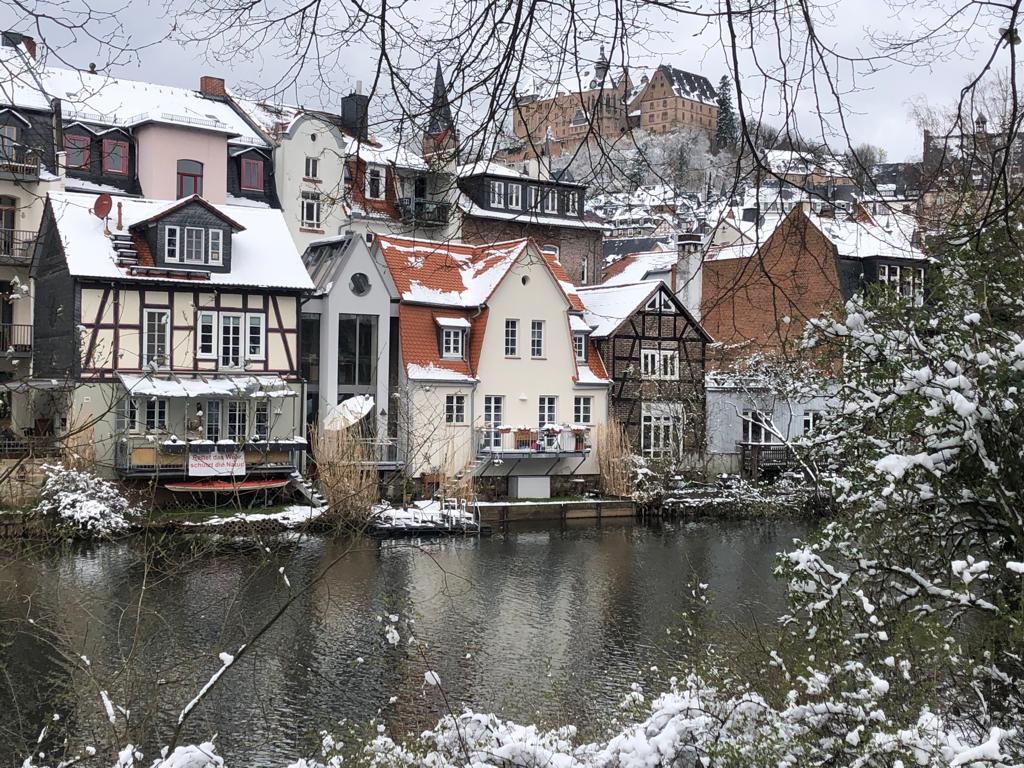
However, when one looks beyond the surface, significant social inequalities emerge. Some neighborhoods, like Marbach or Ortenberg, are very nice, with lovely family houses on large properties. Other areas, such as Waldtal and Richtsberg are dominated by run-down high-rise buildings with public lawns in between.
In our project on Inequality in Marburg, we are starting to document such inequalities in the form of maps. As a first impression, you can see in the image below, the population density is much higher in areas like Waldtal, compared to a neighborhood like Marbach. Sometimes these contrasts appear in one and the same district, like in Wehrda.
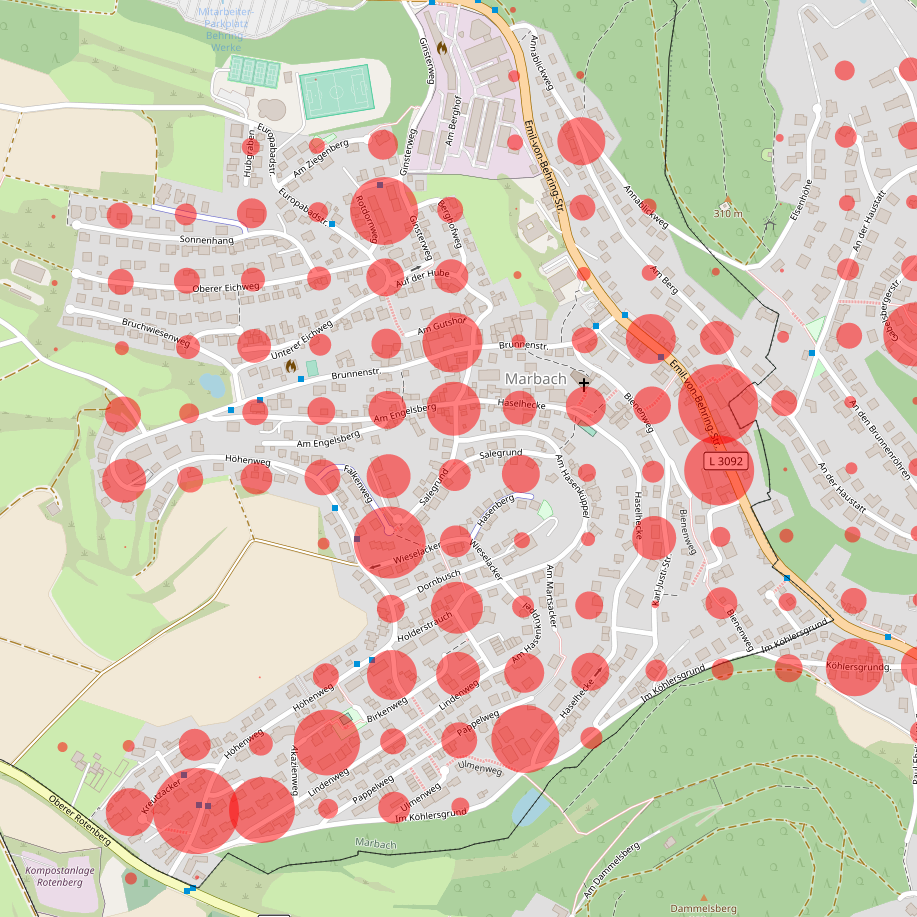
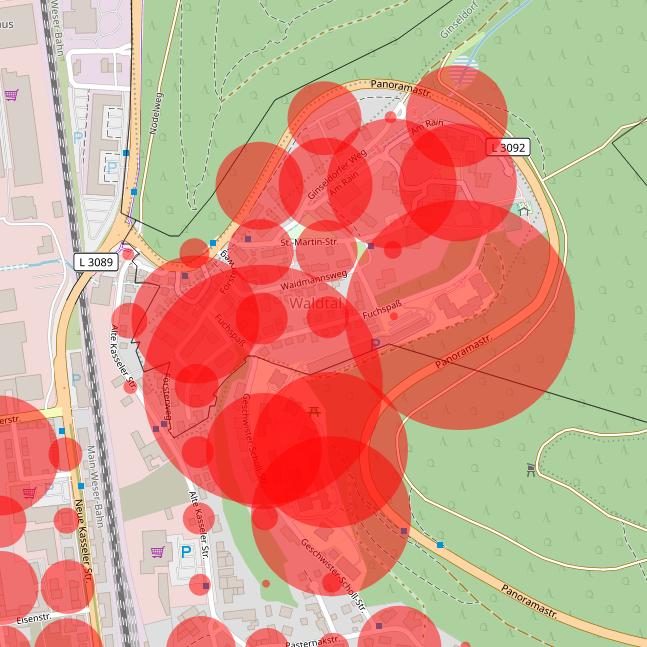
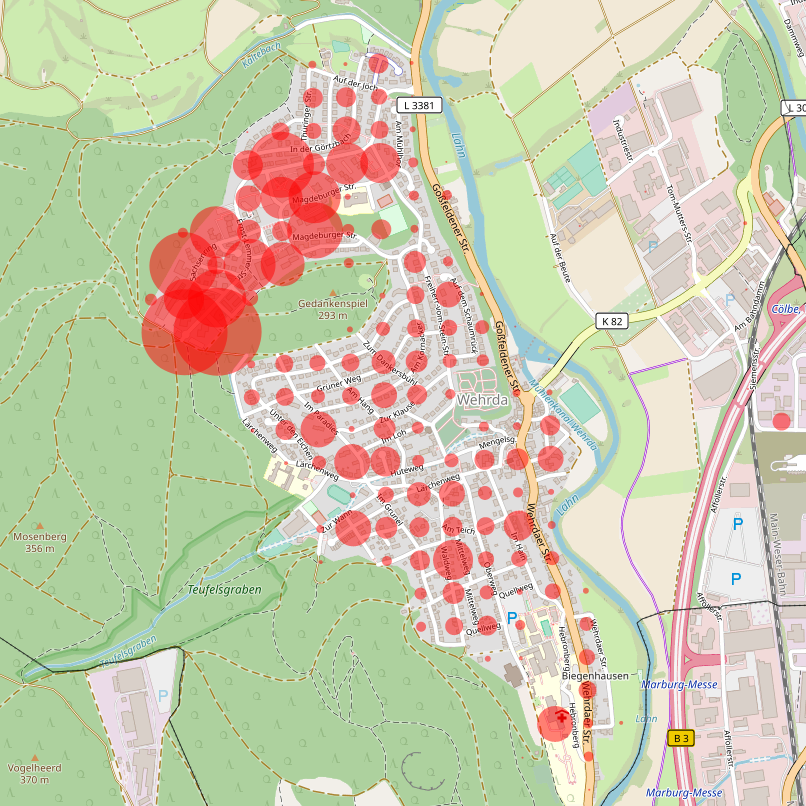
There are other indicators for these discrepancies, as well. We have gathered data on the quota of welfare recipients in each of Marburg’s 33 statistical districts. The numbers reflect the aggregation of recipients of both SGB II and SGB XII payments1. Many people receiving these payments are affected by material deprivation and, in order to be eligible for this kind of benefit, all of them need to be in serious trouble supporting themselves. The standard monthly rate of SGB II payments is €502 in 2023. To get a feeling of what this might mean, consider the amounts budgeted for different needs: the largest share, ca. €174, is meant to be for food and drinks. Hygiene items (soap, shampoo,toothpaste etc.) are budgeted with ca. €19 and education with less than €2.
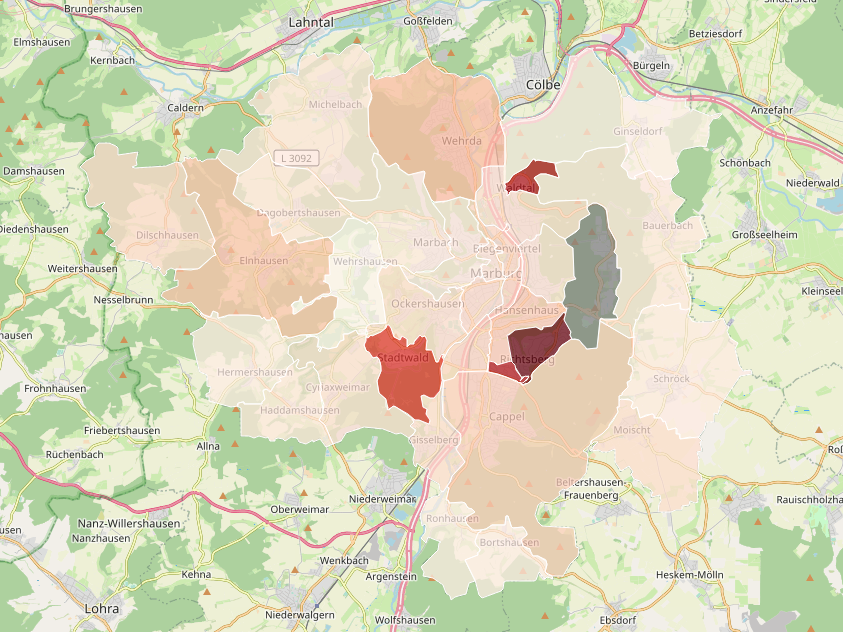
The first thing that is immediately apparent from this map is that four districts really stand out from all the others in a negative way: Stadtwald, Waldtal, Unterer Richtsberg and Oberer Richtsberg. In Stadtwald more than a quarter of inhabitants (including children) cannot secure their basic livelihoods without this type of government assistance, and in Oberer Richtsberg it is even close to 40%. These numbers are in stark contrast to districts like Marbach or Ortenberg, where barely any resident receives welfare payments. Welfare recipients are clearly concentrated in a handful of districts, physically separated from other residential areas of the city, revealing a striking pattern of residential segregation.
As our name suggests, we as a research group are particularly interested in relations between inequality and politics so we are interested in understanding how these sizeable inequalities within Marburg relate to politics. A natural place to start is to ask whether these socioeconomic differences lead to political differences, especially in terms of political participation and engagement.
In general, we know that people with a lower socioeconomic status are less likely to participate in political processes. There are multiple potential reasons for this. Some scholars (e.g. Verba et al. 1995) focus on characteristics of individuals, arguing that people of lower socioeconomic status have fewer resources and so any form of political participation is more costly for them. Others emphasize the role of contextual characteristics and institutions (e.g. electoral rules, party systems etc.) in shaping the costs of voting (see Geys 2006, Blais 2006). Gallego (2008) argues that it is a combination of the two, meaning that contextual characteristics increasing the costs of participation disproportionately affect those with fewer resources.
And indeed, in Germany, if we order citizens from poorer to richer and group them into five groups (quintiles), poorer quintiles turnout to vote ubstantially less than richer quintiles.2
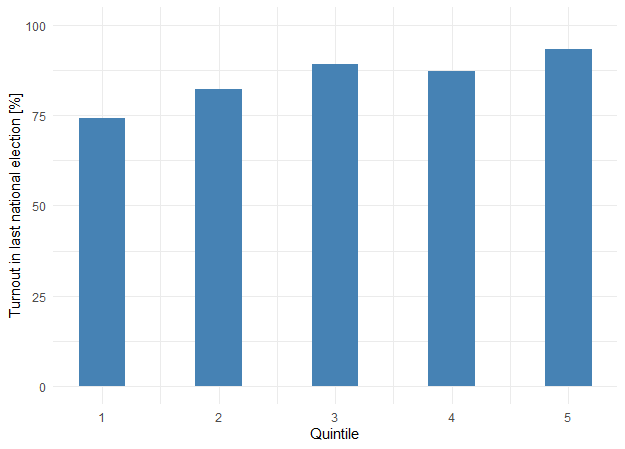
We wanted to find out if this pattern applies to Marburg, so we gathered data from the city-hall on voter turnout. We focused initially on the latest city council elections in March 2021. The results were truly shocking to us. As you can see in the image below, the four districts with distinctly high welfare quotas feature low or very low turnout numbers.3 At a citywide turnout of 55.1%, Stadtwald (47%) had the highest turnout of the four, while Waldtal (38.6%) and Unterer Richtsberg (36%) were already significantly below that. In Oberer Richtsberg, turnout was particularly low at 29.6%. In comparison, in Marbach (62.8%) and Ortenberg (61.9%), turnout was more than twice as high.


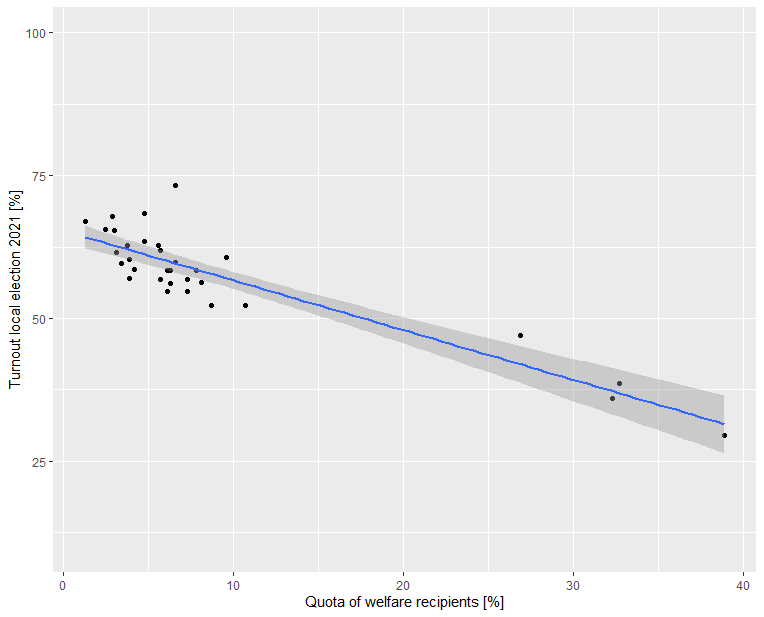
This pattern is really strong and applies to less extreme cases, as well. Looking at the scatterplot above, one can see a strong and significant negative correlation between a district’s welfare quota and voter turnout. It is not only driven by the four districts with high quota of welfare recipients (on the right of the plot); even among the other districts (on the left side), there is a pattern whereby richer districts have a higher turnout.
Of course, this could be a one-time event, especially given that this election was heavily affected by Covid and occurred during a lockdown. So, to be sure, we did the same analysis for the previous local election in 2016. And as you can see in the graph below (left panel), the pattern is nearly identical.
Next, we wanted to check if this extreme pattern hold only for local elections, or is it also present in national elections. There are reasons to believe that participation in local elections may be particular unequal: The “law of dispersion”, originally coined by Tingsten (1937), states that elections with high turnout are a lot less unequal regarding socioeconomic factors than those with low turnout.4 In local elections, turnout is routinely lower than in other elections for higher levels of government, especially national elections, so the inequality pattern there may be particularly acute.
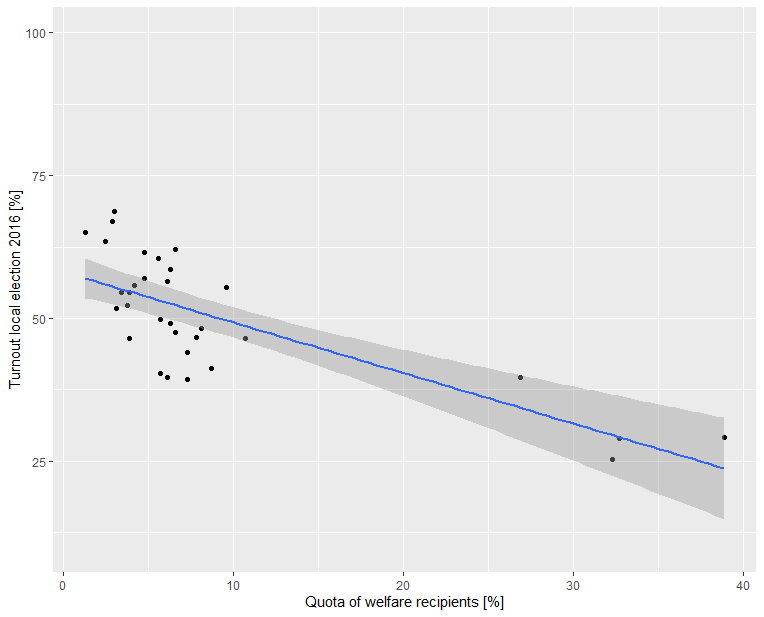
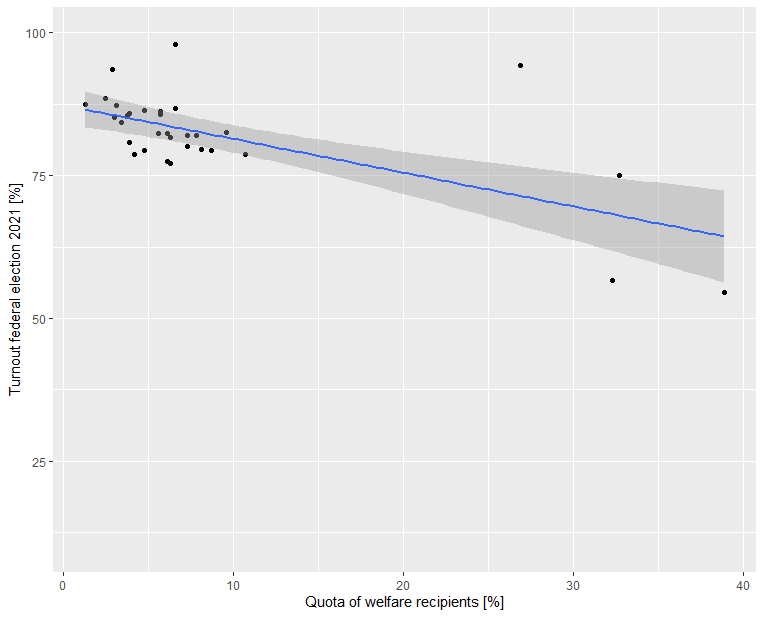
In the latest national election in September 2021, Marburg’s citywide turnout was at 80.25%, substantially higher than in local elections. When we checked the extent of unequal participation in those elections, we found that the pattern of lower turnout in poorer neighborhoods is still there and is quite sizeable, although not as strong as for the local elections
As academics researching inequality and politics, we are concerned about the unequal participation in local elections in general. But sometimes by focusing on inequalities and injustices far away, we forget to consider those that occur around us, in our own community. We believe it is important to pay attention to those as well. The very low level of turnout in the poorest areas of Marburg is worrying and brings up a set of questions that we as a community should strive to answer. First and foremost, the issue of why the poorest citizens of Marburg participate so very little in political processes. What stands in the way of higher turnout of these socioeconomic groups? Do they face specific barriers, or do they lack interest? Or do they maybe believe, in contrast to the more affluent, that local politics has nothing to offer them?
Additionally, we should try to find out whether their preferences, problems and priorities are represented in Marburg’s local politics. As mentioned above, left parties have governed the city during the last decades, but the question emerges: who has brought them to power given that the poorer members of the community vote in so small numbers? And therefore, whose voter interests do they represent? To understand this, we need to learn about the political preferences and grievances that citizens in poorer areas in Marburg might have with regards to local politics: What are the problems and priorities of the city’s poor? How would they like the local government to spend its budget? And do councilors actually know about the issues that are important to them?
And finally, another set of relevant questions regards policymaking. Is it possible that the lack of participation of poorer communities in Marburg has consequences for policymaking? Could it be that the decisions of the local government reflect this lack of participation. More specifically we need to examine how the budget is spent, as this is where the council exercises its greatest power. Are the city’s very considerable resources spent on topics the poor care about, relative to what is allocated to the affluent’s priorities? And going from there, does the actual policymaking feed back into the lack of engagement of the poorest citizens, cementing or even increasing the level of unequal participation? We hope to address these questions within the IDP research team in the coming years.
1 SGB II payments are basic social assistance for individuals who are classified as fit for employment, while SGB XII payments are primarily received by individuals who are classified as unfit for employment due to age or health condition.
2 The data come from the 2018 European Social Survey (ESS), a survey that regularly asks people across Europe about a variety of topics, including socioeconomic status and political interest and affiliation.
3 Voter turnout is calculated over the number of eligible voters so that differences in the number of people holding German citizenship (or EU citizenship in local elections) between these districts do not matter for turnout
4 This seems only logical: If a very high share of people votes, no large group can be severely underrepresented. But if relatively few people cast their ballot, they are likely to be recruited from the groups that are generally more politically engaged. For recent empirical studies testing the law of dispersion, see Persson et al. (2013), Bhatti et al. (2018), and Haußner and Kaeding (2019).
References
Bhatti, Yosef, Jens Olav Dahlgaard, Jonas Hedegaard Hansen, and Kasper M. Hansen. 2019. Core and Peripheral Voters: Predictors of Turnout Across Three Types of Elections. Political Studies 67 (2): 348–366. DOI: 10.1177/0032321718766246.
Blais, André, John H. Aldrich, Indridi H. Indridason, and Renan Levine. 2006. Do Voters Vote For Government Coalitions? Party Politics 12 (6): 691–705. DOI: 10.1177/1354068806068594.
Gallego, Aina. 2015. Unequal Political Participation Worldwide. Cambridge University Press.
Geys, Benny. 2006. Explaining voter turnout: A review of aggregate-level research. Electoral Studies 25 (4): 637–663. DOI: 10.1016/j.electstud.2005.09.002.
Haußner, Stefan, and Michael Kaeding. 2019. Der erste Eindruck trügt: Eine Analyse der Wahlbeteiligung der Bundestagswahl 2017 auf Bundes-, Landes- und Städteebene im europäischen Kontext. In Die Bundestagswahl 2017, ed. Karl-Rudolf Korte and Jan Schoofs, 177–197. Wiesbaden: Springer Fachmedien Wiesbaden.
Persson, Mikael, Maria Solevid, and Richard Öhrvall. 2013. Voter Turnout and Political Equality: Testing the ‘Law of Dispersion’ in a Swedish Natural Experiment. Politics 33 (3): 172–184. DOI: 10.1111/1467-9256.12012.
Tingsten, Heribert. 1937. Political Behavior: Studies in Election Statistics. American Political Science Review 31 (6): 1164–1165.
Verba, Sidney, Kay Lehman Schlozman, and Henry E. Brady. 1995. Voice and equality: Civic voluntarism in American politics, 4th edn. Cambridge, Mass.: Harvard Univ. Press.
